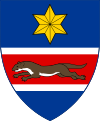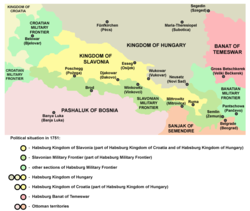Queen of Slavonia
| Kingdom of Slavonia | ||||||||||
| Separate Habsburg land under joint civil-military administration (1699–1745), Land of the Crown of St Stephen within the Habsburg Monarchy (1745–1804)a Constituent land of the Austrian Empire (1804–1868)a |
||||||||||
|
||||||||||
|
Kingdom of Slavonia in 1751, shown in yellow
|
||||||||||
| Capital | Osijek | |||||||||
| Languages |
Official: Latin (until 1784; 1790–1847) German (1784–1790) Croatian (1847–1868) |
|||||||||
| Religion | ||||||||||
| Government | Monarchy | |||||||||
| Ban (Viceroy) | ||||||||||
| • | 1699–1703 | Adam Batthyány (first) | ||||||||
| • | 1848–1859 | Josip Jelačić (notable) | ||||||||
| • | 1867–1868 | Levin Rauch (last) | ||||||||
| Legislature | Sabor | |||||||||
| Historical era | Early modern period | |||||||||
| • | Treaty of Karlowitz | 26 January 1699 | ||||||||
| • | Revolution of 1848 | 15 March 1848 | ||||||||
| • | Settlement of 1868 | 26 September 1868 | ||||||||
| Area | ||||||||||
| • | 1868 | 9,246 km2 (3,570 sq mi) | ||||||||
| Population | ||||||||||
| • | 1868 est. | 381,480 | ||||||||
| Density | 41/km2 (107/sq mi) | |||||||||
| Currency | Gulden | |||||||||
|
||||||||||
| Today part of |
|
|||||||||
| A: Subordinate to the Kingdom of Croatia and to the Kingdom of Hungary (1745–1849), autonomous part of the Kingdom of Croatia and the Austrian Empire (1849 - 1868) | ||||||||||
The Kingdom of Slavonia (Croatian: Kraljevina Slavonija; German: Königreich Slawonien; Latin: Regnum Sclavoniae; Hungarian: Szlavón Királyság) was a province of the Habsburg Monarchy and the Austrian Empire that existed from 1699 to 1868. The province included northern parts of present-day regions of Slavonia (today in Croatia) and Syrmia (today in Serbia and Croatia). The southern parts of these regions were part of the Slavonian Military Frontier, which was a section of the Military Frontier.
The Kingdom of Slavonia was bounded by the Kingdom of Croatia to the west, the Kingdom of Hungary to the north and the east, and by the Ottoman Empire to the south. Together with the Slavonian Military Frontier it had about 6600 sq. miles. It was divided into the three counties of Požega, Virovitica and Syrmia. Besides a chain of mountains in the middle of the province, the remaining part of Slavonian Kingdom consisted of fertile eminences planted with vines and fruit trees and extensive plains.
The Kingdom of Slavonia was formed from territories that Habsburg Monarchy gained from Ottoman Empire by the Treaty of Karlowitz (1699), that ended the Great Turkish War. Initially, it was a separate Habsburg land under joint civil-military administration that lasted from 1699 to 1745. The inhabitants were exempted from taxes, but were bound to military service. In 1745, the full civil administration was introduced and Kingdom of Slavonia, as one of the Lands of the Crown of St. Stephen, was administratively included into both Kingdom of Croatia and Kingdom of Hungary. Following the 1868 Settlement (Nagodba) with the Kingdom of Hungary, Kingdom of Slavonia was joined with Kingdom of Croatia into the single Kingdom of Croatia-Slavonia, which although it was under the suzerainty of the Crown of Saint Stephen kept a significant level of self-rule.
...
Wikipedia



